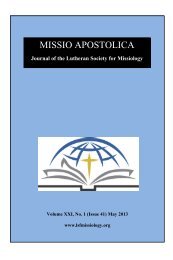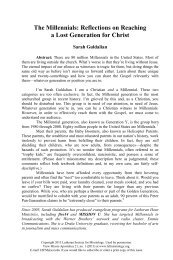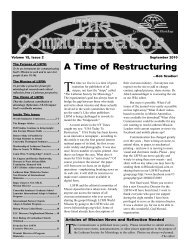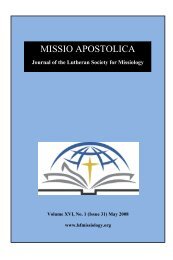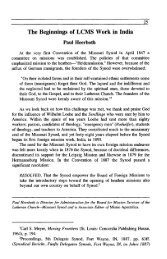Ritual and Animism - Lutheran Society for Missiology
Ritual and Animism - Lutheran Society for Missiology
Ritual and Animism - Lutheran Society for Missiology
Create successful ePaper yourself
Turn your PDF publications into a flip-book with our unique Google optimized e-Paper software.
4 Missio Apostolica<br />
Articles<br />
<strong>Ritual</strong> <strong>and</strong> <strong>Animism</strong>:<br />
Liturgical Symbols <strong>and</strong> <strong>Ritual</strong><br />
in an Animistic Context-<br />
What Do They Mean<br />
Douglas L. Rutt<br />
"It's only wood!" she exclaimed-as if that were a big surprise. We were<br />
visiting the ancient church of San Francisco in Antigua. Guatemala. This<br />
startling revelation came to our Cakchiquel Indian companion as she pondered<br />
the brokendfarm of the statue of St. Joseph, located in a glass case on top of<br />
an altar along the south wall of the cathedral. In h nt of the altar was a st<strong>and</strong><br />
with a metal tray to catch the wax drippings of the scores of c<strong>and</strong>les placed<br />
behe this statue. I soon learned that Guatemalans did not refer to the statue as<br />
a "statue," that is, as some inanimate object. It was a "saint* in the terminology<br />
of the Guatemalans, with all the honors <strong>and</strong> powers pertaining thereto. It was<br />
hard <strong>for</strong> our Cakchquel fiend to believe that something that possessed such<br />
spiritual power was dd, rotted wood on the inside.<br />
That observation was an introduction fbr me, as a new cross-nrltural worker,<br />
to the implications of what I would later recognize as the animistic world-view<br />
Dr. Douglas L. Rutt is the Area Secretary <strong>for</strong> Latin America of the Board<strong>for</strong><br />
Mission Services of fie <strong>Lutheran</strong> ChurcHissouri Synod He previous@ has<br />
served as a parish pastor, missionary to Guatemala, <strong>and</strong> seminary profssor.<br />
He earned his Doctor of <strong>Missiology</strong> degree at Concordia l7aeological<br />
Seminary in Fort Wayne, with a concentration in the area of Xheologicai<br />
Education.
<strong>Ritual</strong> <strong>and</strong> Anin~ism 5<br />
described by R.R.Marett, that is, that inanimate objects, especially sacred<br />
objects, have life, will <strong>and</strong> feeling.'<br />
Another scene comes to mind. It is a typical Wednesday morning chapel<br />
service at a <strong>Lutheran</strong> seminary in the United States. As the organist plays a<br />
beautifilly elaborate processional on the powefil pipe organ, the officiants<br />
begin to march in. First come two men dressed in white albs, each cartying a<br />
pole with a lit c<strong>and</strong>le mounted on the top. They are stiff <strong>and</strong> serious, holding<br />
their c<strong>and</strong>le holders with great care <strong>and</strong> total concentration. A few paces behind<br />
comes the crucifer in a white alb, using the same care <strong>and</strong> reverence as he<br />
marches <strong>for</strong>ward. All present immediately turn <strong>and</strong> face the crucifix, making<br />
adjustments as it moves <strong>for</strong>ward, keeping their eyes fixed on it as it passes<br />
through the nave, up to the chancel where it is placed in a st<strong>and</strong> near the lectern.<br />
Apparently great care must be taken about how these objects are h<strong>and</strong>led. Behind<br />
the crucifer is another young man, again in a wlute alb, carrying the Bible. It is<br />
no ordinary Bible, <strong>for</strong> it is cradled in a case made of highly ornamented <strong>and</strong><br />
polished gold. Finally the principal officiant follows. He is wearing a white alb<br />
also, in addition to a highly ornate, gold embroidered cope that reaches almost<br />
to the floor. The ofliciants all take up their positions in the chancel area just as<br />
the organist completes his processional-perfect timing. The question: What<br />
does it mean Especially, what would it mean to someone whose world-view is<br />
animistic<br />
To better underst<strong>and</strong> how a culture in which an animistic world-view<br />
prevails might interpret symbolism <strong>and</strong> ritual, it is first necessary to underst<strong>and</strong><br />
how world-view permeates every level of human underst<strong>and</strong>ing. As Donna Strom<br />
\-rote:<br />
While ethnographies list religion as one category of culture, I would add<br />
two biblical considerations. First, culture, like the human body, is one<br />
complex integrated whole. You may dissect a body <strong>and</strong> analyze its parts; but<br />
stub your toe <strong>and</strong> your whole body reacts. Similarly, though some<br />
anthropologists view religion as superstition or magic, they agree that<br />
religion affects all of culture.<br />
"'Primitive Religion," s.v. <strong>Lutheran</strong> Cyclopedia, ed. Erwin L. Lueker (St.<br />
Louis: Concordia Publishing House, 1975), 639.
6 Missio Apostolica<br />
Why At the heart of every culture is its world-view-peoples'<br />
perception of themselves in relation to life <strong>and</strong> the universe. This worldview<br />
dominates <strong>and</strong> determines all else. The apostle Paul said of ow creator:<br />
"He existed prior to all things, <strong>and</strong> in him all things hold together" (Col.<br />
1: 17), <strong>and</strong> "In him we live <strong>and</strong> move <strong>and</strong> have our being" (Acts 17:28).'<br />
There are many ways of defining culture as it pertains to anthropological<br />
underst<strong>and</strong>ing <strong>and</strong> communication theory. Since we are interested more<br />
specifcially in world-view, Charles Kraft's unpretentious definition of culture<br />
will suI3ic.e: "Our culture is that m terms of which our life is organi~ed."~ Culture<br />
provides the organizational basis <strong>for</strong> our lives, ow actions, what is acceptable.<br />
World-view, on the other h<strong>and</strong>, provides the basis upon which st<strong>and</strong>s our<br />
underst<strong>and</strong>ing of things, how they work, <strong>and</strong> what they mean. That is why it is<br />
so important to have an adequate underst<strong>and</strong>ing of the world-view of the society<br />
to which one intends to communicate the gospel. World-view comprises the<br />
assumptions that human beings make about realitye4 One's world-view<br />
determines one's concepts of time, space, the world, life, death, spiritual <strong>and</strong><br />
physical things, the relationshp between them, <strong>and</strong> whether a distinction is even<br />
made.<br />
Bunkowske has provided a valuable model <strong>for</strong> underst<strong>and</strong>ing culture <strong>and</strong> the<br />
importance ofworld-view.5 His model is similar to that of Hiebert; however, he<br />
arranges several domains in sequential order. He compares culture <strong>and</strong> worldview<br />
to he various skin layers of the onion, beginning with artifacts as the outer<br />
layer <strong>and</strong> proceeding inward to the center, with behavior, values, beliefs, <strong>and</strong><br />
2Dcmna Strom, ''Cultural Practices-J3atth or Bridges" Evangelical Missions<br />
Quarterly 23 (1987): 249.<br />
3Charles H. Kraft, Christianity in Culture: A Study in mnamic Biblical<br />
Theologizing in Cross-Cultural Perspective (Maryknoll, NY: Orbis Books,<br />
1979), 47.<br />
4Paul G. Hiebert, Anthropoiogicai Insights<strong>for</strong> n/iissionarie (Gr<strong>and</strong> Rapids:<br />
Baker Book House, 1985), 45.<br />
'Eugene W. Bunkowske, "Booting Up <strong>for</strong> Receptor Oriented Gospel<br />
Communication," in Receptor Oriented Gospel Comnicatioti: Making the<br />
Gospel User Friendly, ed. Eugene W. Bunkowske <strong>and</strong> Richard French<br />
(Fullerton, CA: R.C. Law & Co, 1989), 29.
<strong>Ritual</strong> <strong>and</strong> <strong>Animism</strong> 7<br />
world-view matcJxd with what is collected, what is done, what is goodhad, what<br />
is true, <strong>and</strong> what is real. By means of visualizing the onion in this manner, it is<br />
possible to see how one could institute a change of outward behavior among<br />
those to whom one is witnessing, without sigruficant change having taken place<br />
at the levels represented by the inner circles. A Christian symbol such as a cross<br />
can substitute a pagan reIigious artifact, <strong>for</strong> example, an amulet. This does not<br />
necessarily signifj, howem, that an accompanying change has taken place in the<br />
domain of values, beliefs, <strong>and</strong> least of all, world-view. Outward behavior can<br />
undergo alteration, such as attendance at Sunday morning Christian worship<br />
services, without meaningfi~l trans<strong>for</strong>mation at the levels related to issues of<br />
goodhad or huth.<br />
World-view controls one's assumptions about what is real. It is at that level<br />
that one's ultimate reality is determined. <strong>and</strong> in effect, the level of ultimate<br />
allegiance. True Christian conversion, there<strong>for</strong>e, must take place at the worldview<br />
level, <strong>for</strong> only at that level are the issues of ultimate truth settled.<br />
If evangelistic attempts focus on the external levels of culture, <strong>and</strong> if<br />
conversion is based upon the use of certain e c t s or compliance with certain<br />
religious practices, such as was the case of the Spanish conquest of Latin<br />
America, the way is open <strong>for</strong> a syncretistic blending of old <strong>and</strong> new customs,<br />
which in actudty lnay not have made a substantial difference in world-view, or<br />
at least may not have effected conversion at the world-view level. Countless<br />
examples of syncretism are available fiom the Latin American context. Carrasco<br />
has briefly summarized the effects of syncretism as follows:<br />
Throughout Mesoamerica today groups carry out ceremonies combining a<br />
wide range of native <strong>and</strong> Catholic symbols <strong>and</strong> beliefs into new pattems of<br />
meanings. And it is primarily within the experience of ritual action that<br />
syncretism becomes an authentic dimmion of life. For the rituds create the<br />
legitimate setting <strong>and</strong> charged atmosphere <strong>for</strong> the placing of incongruent<br />
objects, symbols, sounds, <strong>and</strong> ideas together in an acceptable way. This<br />
results in new versions of the older patterns. The images of Christ <strong>and</strong> the<br />
Saints have received a rich series of innovations in Mexico. A good example<br />
are the many colonial church-yard crosses that still st<strong>and</strong> in Mexico. Many<br />
appear, on first glance, to be symbols of a European Christian presence. But<br />
on cIoser view it is clear that many echo preconquest designs, emotions,<br />
conceptim of spahal arrangement, <strong>and</strong> style. Further reflection leads to the<br />
realization that these crosses ate neither Eutopean nor Indian, but<br />
Mexi- fluid syncretic image of new power, dsmticm, <strong>and</strong> combined
8 Missio Apostolica<br />
meanings.<br />
It is beyond the scope of this article to elaborate additional examples of<br />
syncretism. Suff~ce it to say that when it occurs, by defdtion, adequate gospel<br />
communication has not taken place. McGam has written: "When, in adjusting<br />
to culture, Christianity becomes unlike itself, takes on the color <strong>and</strong> genius of<br />
another religion <strong>and</strong> loses its soul, then its power to save is destroyed."'<br />
While syncretism is always a threat, it is not necessarily only those<br />
attempting to Christianize old symbols or ritual <strong>for</strong>ms fiom a non-western host<br />
culture who bring it about, as did the Spanish conquerors, who often constructed<br />
their cathedrals on the holy grounds of the indigenous inhabitants. Syncretism<br />
can also be caused by attempts to preserve Christian <strong>for</strong>ms that have no meaning<br />
or misunderstood meanings in tile new cultural context.<br />
Communication<br />
World-view, then, deeply affects the meaning far the receptor of any<br />
particular communication. There<strong>for</strong>e it is of paramount importance as it relates<br />
to cumnndcation rbary. Not only does true conversion take place at the worldview<br />
level, but also communication, if it is to be effective, must be aimed at the<br />
world-view of the hearer. As Charles Kraft has stated it with characteristic<br />
simplicity: "It is the receptor who has the find say concerning what is<br />
~ommunicated."~ The receptor will need to make sense of the signs hdshe<br />
receives, <strong>and</strong> again, that depends on world-view.'<br />
6David Carrasco, Religions ofMesoamerica: Cosmovision <strong>and</strong> Ceremonial<br />
Centers (San Francisco: Harper <strong>and</strong> Row, 19901, 126.<br />
-Donald A McGavran, ''The Bible Base from which Adjustments are Made," in<br />
Christopaganism or Indigenous Christianity, ed. Tetsunao Yamamori <strong>and</strong><br />
Charles R. Taber (Pasadena: William Carey Library, 1975), 45.<br />
'Charles H. Kra€t, Communicntron Theory<strong>for</strong> Christian Witness (Nashville:<br />
Abingdon Press, 1983),49.<br />
'James W. Vdz, "Receptor Oriented Interpretation of the HoIy Scriptures," in<br />
Receptor Oriented Gospel Comunication: Mahg the Gospel User Friendly,<br />
ed. Eugene W. Bunlcowske <strong>and</strong> Richard French (Fullerton, CA: R.C. Law k<br />
Co., 1988), 53.
<strong>Ritual</strong> <strong>and</strong> <strong>Animism</strong> 9<br />
There has been much debate over the relationd~ip between fonn <strong>and</strong><br />
meaning in <strong>Lutheran</strong> circles.1° Tlle receptor orientation of communication can be<br />
carried to the exwme so that <strong>for</strong>m is viewed as having little to do with meaning.<br />
Some might say that it is necessary to completely rewrite the Bible, <strong>for</strong> example,<br />
to look <strong>for</strong> "dynamic equivalence" in conveying meaning. Wl~ile dynamic<br />
equivalence as described by Nida has validity as a translation principle, it too<br />
has its limits." As Smalley has said:<br />
To say that language structure <strong>and</strong> meaning are different is not to sa, that<br />
they can ever be divorced from each other. But they are different. <strong>and</strong> the<br />
ability to keep this diffcrence in mind is of great importance to the linguist<br />
who works with a variety of languages in an analytical way. It can make his<br />
underst<strong>and</strong>ing of both <strong>for</strong>m <strong>and</strong> meaning clearer as it separates out the<br />
variables which are found fioxn language to language.12<br />
Viewing liturgical s)mbolism <strong>and</strong> ritual as communicafion (altl~ough it<br />
certainly can be more than that), the same principle would apply regarding the<br />
fondmeaning distinction. This would ntean that the significance or meaning <strong>for</strong><br />
those observing liturgical practice or symbolism is finally in the h<strong>and</strong>s of the<br />
receptor. That is not to say. however, that there is no connection between the<br />
<strong>for</strong>m of liturgics <strong>and</strong> its meaning. Returning to Bunkowske's "onion skin"<br />
example of culture, we note that there is an interrelationship or movement of<br />
underst<strong>and</strong>mg flowing in both directions between the levels. In other words, the<br />
use of certain artifacts, or the adjustments of certain behaviors, could have an<br />
effect upon the inner. deeper levels, even as far as world-view. Similarly, a<br />
change in world-view certainIy can cause great adjustments in behavior or<br />
artifacts. The external <strong>and</strong> the internal levels cannot be segmented, separated or<br />
''David S. Luecke's Evangelical Style <strong>and</strong> <strong>Lutheran</strong> Substance (St. Louis:<br />
Concordia Publishing House, 1985) is an example of an attempt to separate <strong>for</strong>m<br />
from substance.<br />
I1<br />
Eugene A. Nida, Message <strong>and</strong>Mission: The Communication of the Christian<br />
Faith (Pasadena: Williani Carey Library, 1960), 155.<br />
''Paul Abrecht <strong>and</strong> William A. Smalley, "The Moral Implications of Social<br />
Structure," in Readings in Missionary Anthropology, ed. William A. SmaIIey<br />
(Pasadena: William Carey Library, 1974), 120. Emphasis addcd.
10 Missio Apostolica<br />
compartmentalized so neatly. l3<br />
The challenge, then, as it relates to the communication of the gospel,<br />
whether it be by words or actions, is to convey the conceptualization of the<br />
ammmicator to the hearer with as little noise or interference as possible, so that<br />
what the hearer conceptoafizes &er the commdcation proximates, in as much<br />
as humanly possible, what the communicator intended.<br />
Importance of <strong>Ritual</strong><br />
For some modern* Christians the idea of ritual in <strong>and</strong> of itself is almost<br />
taboo. The practices of the <strong>Lutheran</strong> church, <strong>for</strong> example, came under frequent<br />
criticism by those of the Evangelical missionary community in Guatemala due<br />
to its use of liturgical ritual <strong>and</strong> symbolism. Any kind of worship activity that<br />
emplays objects such as a cross, an alb or stole, or follows a traditional liturgical<br />
order, is br<strong>and</strong>ed as "idolatry." Often the charge is made: "The <strong>Lutheran</strong>s rue just<br />
like Catholics lnI4<br />
<strong>Lutheran</strong>s in Guatemala, however, believe that ritual <strong>and</strong> symbols ought not<br />
be rejected so quickly <strong>and</strong> read!ly <strong>Ritual</strong> is an effective <strong>and</strong> powerful element of<br />
religion, especially m Latin American context^.'^ Human beings need ritual to<br />
help satisfy many cravings <strong>and</strong> yearnings <strong>for</strong> meaning. Even the secular<br />
anthropologists recognize the validity of ritual as an integrating fbctor that<br />
promotes religious commitment:<br />
It is through ritual tbat religion is able to impress on people a commitment<br />
to their system ofreligious beliefs. Participants in a religious ritual are able<br />
to expms group soIidanty <strong>and</strong> loyalty. Emile Durkheim argued that the true<br />
nature of religion was ritual participation. of course, history abounds with<br />
examples of the importance of the individual expexiaw in religious; yet<br />
there is no denying the overwhelming effect of group participation. As<br />
WilIiam Howells h4ls pointed out, ritual helps individuals but does so by<br />
I3Compare James 3: 1-1 1 with Matthew 5: 19<br />
I4This, even though the <strong>Lutheran</strong> underst<strong>and</strong>ings of grace, justihtion, <strong>and</strong><br />
conversion are not nearly as close to those of the Catholic church as are the<br />
lmderst<strong>and</strong>ings ofthe individuals making that charge. Obviously it is a problem<br />
of communication <strong>and</strong> world-view.<br />
'Wida, Message <strong>and</strong> Mission, 23.
<strong>Ritual</strong> <strong>and</strong> <strong>Animism</strong> 1 1<br />
treating then1 as a whole group: "tl~ey arc like a tangled head of liair. <strong>and</strong><br />
ritual is the comb."<br />
<strong>Ritual</strong> in this sense contirms socio/religious status <strong>and</strong> helps to maintain<br />
appropriate relationships.<br />
Hiebert has pointed out the value of religious symboIism <strong>and</strong> sacred ritual<br />
in terms of bracketing, that is, time or space is set aside <strong>for</strong> significant religious<br />
experience, or "bracketed," by using symbols or ritual.16 It is a mechanism by<br />
\vhiclt one knows it is time to concentrate on Utings eternal <strong>and</strong> of transcendental<br />
importance. He maintains that the Ioss of sacred language or symbols would<br />
mean the loss of our ability to talk in a meaningful way of ultimate reality.<br />
Another element of value in ritual is its ability to coi~ununicate <strong>and</strong> teach.<br />
Liturgical ritual is beneficial because it <strong>for</strong>mulates <strong>and</strong> expresses tlieological<br />
trudis in precise, orgmved tern~inology. The rcpctitiveness of these <strong>for</strong>mulations<br />
assists in tl~e process of assimilation. This writer has visited many elderly,<br />
otl~erwise seniIe, men <strong>and</strong> women who were yet able to express their faith <strong>and</strong><br />
11ope using the words of tl~e Apostles' Creed or another liturgical statement that<br />
had long ago been ingrained in their minds.<br />
Liturgical ritual <strong>and</strong> symbolism are important because they assure that the<br />
essence of the gospel is communicated during each worship service. When a<br />
worslup service takes place without the benefit of a liturgy, tlze burden of clear,<br />
precise <strong>and</strong> adequate enunciation of the gospel rests on t l shoulders ~ of the<br />
preacher or others who perhaps huniedly organized the order of worship. In the<br />
same way, liturgy can preserve the Gospel during times of spiritual darkness or<br />
doctrinal apostasy on the part of church leadership. No doubt the essence of the<br />
gospel was presewed be<strong>for</strong>e the time of the Re<strong>for</strong>mation, in part, because it was<br />
expressed in many orders of mass, though the priest may not have clearly<br />
articulated it homiletically.<br />
Liturgical ritual <strong>and</strong> symbolism are more, however, than simple<br />
communicaticm. While the western world-view tends to see religious experience<br />
as a matter of words, in<strong>for</strong>mation, or message, it is much more than that. <strong>Ritual</strong><br />
<strong>and</strong> symbolism can have impact beyond that of mere words when it is understood<br />
as per<strong>for</strong>mance as well." When ritual is seen as per<strong>for</strong>mance, not only is a<br />
16Paul G. Hiebert, Phenomenologv <strong>and</strong> Institutions ofFalk Religions, course<br />
syllabus, Pasadena: Fuller School of World Missions, 1988<br />
"Hiebert, Phenomenology, 1 14.
12 Mis.~io Apostolica<br />
message con~inunicated. but a change indeed takes place. While not all<br />
evangelical Christians wti\.ill agree ~i~illi illis illustration, an example would be the<br />
practice of absolution. The officiant states something like: "As a called <strong>and</strong><br />
ordained servant of the word, 1 <strong>for</strong>give you all of your sins." This statement is<br />
problematic even <strong>for</strong> man!, Lutl~enns of a western mindset. They ask, what right<br />
does the minister have to <strong>for</strong>give sins <strong>Lutheran</strong> theology esplains it as a right<br />
that Christ did give to the church (Joim 20.23, Matthew 16: 19; 18: 18). Tl~e<br />
minister is exercising that right on behalf of <strong>and</strong> in the name of the church. The<br />
point is, howeyer, that a change is taking place: The worship participant is<br />
actually receiving the <strong>for</strong>giveness of sins through that act of absolution (based,<br />
of course, upon Cllrist's vicarious atonement).<br />
Carlos Valle spoke to this when he compared three worsl~ip services that he<br />
attended in a Latin American city. The fmt two services were in different ancient<br />
Roman Catholic church buildings. One Catholic inass was with poorer<br />
wvorslipers, the other with a more duent group of people in attendance. Typical<br />
deficiencies were found, yet something was happening. A per<strong>for</strong>mance was<br />
taking place that seemed to have great meaning to the wvorshipers.'ihe third<br />
worship service .tvhicl~ Valle attended was in a Protestant church. The worship<br />
setting <strong>for</strong> that senrice was a large hall with almost no aesthetic qualities,<br />
symbolism or architectural uniqueness. Tile entire service was, according to<br />
Valle, a rally around words. As he reported:<br />
There is a total absence of symbols. except <strong>for</strong> a Bible verse which attracts<br />
the congregations' attention. People are dressed up as <strong>for</strong> a party. Words<br />
dominate the meeting. Words are used to explain words. A central pulpit<br />
comm<strong>and</strong>s the attention of all participants. A long emotional speech<br />
becomes the morning's main experience.18<br />
Considering Hiebert's discussion of "bracketing," it seems that such a group of<br />
worslupers is running the risk of losing much of its ability to talk about ultimate<br />
reality in a meaningfir1 way. Perhaps bracketing is taking place, but it is barely<br />
perceptible. At ary rate, the sense of per<strong>for</strong>mance in worship is greatly reduced.<br />
The worship service of this group was conducted in such an austere way,<br />
according to the author, because it was a <strong>for</strong>m imported from the North American<br />
world-view. Valle concluded that the worshipers were being denied a mly<br />
'Varlos Valle. "Historical <strong>and</strong> Cultural Elements in Christian Communication."<br />
Latin American Pastoral Issues, 15, no. 1 (July 1988): 7.
<strong>Ritual</strong> <strong>and</strong> <strong>Animism</strong> 13<br />
integrating religious experience.<br />
Attempts to differentiate between <strong>for</strong>m <strong>and</strong> meaning notwithst<strong>and</strong>ing, in<br />
many cultures, especially in animistic cultures. <strong>for</strong>m <strong>and</strong> meaning are much more<br />
readily equated.19 <strong>Ritual</strong> as perfomlance nieans that its significance is much<br />
deeper than simple comnunication: it is the acting out <strong>and</strong> establisluuent of<br />
truth-of ult~nlate reality, in a transcendental sense, far beyond what could be<br />
done with mere words. It is something that impacts upon the whole person.<br />
Again, Valle described his experience in the Catllolic masses he attended that<br />
morning:<br />
It has often been said that every audiovisual experience is an emotional<br />
experience <strong>and</strong> what we had witnessed that morning was an audiovisual<br />
experience that Christianity has been providing all along its history. The<br />
sanctuaries, the rites, the gestures <strong>and</strong> the sounds encolnpassed a unity, each<br />
part expressing something of the Christian faith. The experience of<br />
everythmg, the sights <strong>and</strong> sounds, acquired a value <strong>and</strong> a relevance of which<br />
we were hardly conscious. It is like saying: the e.xperience of what<br />
Christianity is actually comes, not through doctrinal questions, no matter<br />
how crucial, but through facts which are seen <strong>and</strong><br />
<strong>Ritual</strong> <strong>and</strong> symbolism can play an important part in the totality of the<br />
Christian experience. Without them something is lost. The concern over what is<br />
transmitted by ritual, however, remains. <strong>Ritual</strong> cannot be used uncritically. lie<br />
world-view of tile receptor must be considered.<br />
Caveats <strong>for</strong> the Use of <strong>Ritual</strong> <strong>and</strong> Symbolism<br />
What is known about world-view <strong>and</strong> communication theory must now be<br />
brought to bear upon particular ritualistic practices or use of symbols. While<br />
ritual <strong>and</strong> symbols are valuable, they can be misunderstood or meaningless if<br />
they are not understood or interpreted by the host culture according to their<br />
original intent.<br />
One example of the lack of <strong>for</strong>mal correspondence was described by Ilkka<br />
I9Hiebert, Anthropological Insights, 39.<br />
20Valle, 7.
~akkuri.~' A Haitian divinity student who accompanied him to a worship service<br />
in the U. S. startled him when they studied the inipressive cross in the chancel<br />
area of the church. He said he would never use a cross in a church in Haiti. The<br />
reason was that Haitians viewed the cross as an instrument of slavery. When the<br />
French wried out punishment, they would say they were doing it "because of the<br />
cmss." The cross m Haitt has become a synibol of esil rather than good. It is<br />
used in Voodoo as are almost all Christian symbols. According to Vakkuril's<br />
Haitian fiiend, nearly all traditional Christian symbols are used <strong>for</strong> the purposes<br />
of Voodoo. The only way to avoid misunderst<strong>and</strong>ing, he said, is to avoid the use<br />
of those symbols in Christian churches.<br />
Here, the animistic world-vlew of the Ha~tian sees artifacts as possessing a<br />
great deal of spiritual power in <strong>and</strong> of themselves. That power may be organic<br />
or mechanistic, it may be good or bad or have no intrinsic moral values. It<br />
certainly is not, however, inherently good, as the cross is <strong>for</strong> many Christians.<br />
The missionary who intends to communicate the gospel in such a setting would<br />
have to be very careful about how religious symbolism <strong>and</strong> ritual are usd to<br />
avoid miscommunication. The problem is that the cross is a fhdamentaI<br />
Christian symbol that teaches (<strong>and</strong> acts out) an important Christian truth. Yet <strong>for</strong><br />
Haitians it has been used in pagan religious practices, as well as an instrument<br />
of oppression. Does he importance of the cross as a Christian symbol outweigh<br />
its negative connotations It is not the simple matter of "education" that some<br />
would like to think. The world-view of people cannot be changed so easily, as<br />
if one were shooing away a fly. It is an integral part of one's seIf---~ne's very<br />
being.<br />
One possible solution to this dilemma would be to not we the cross as a<br />
symboI, while at the same time preaching it (I Corinthians 1 :23). Yet, if ritual<br />
is indeed irnpmt, it seems that some type of functional substitute would have<br />
to be sought so as to not reduce worship <strong>and</strong> religious experience to a "rally<br />
around words. "<br />
Returning to the example of the worship service mentioned at the beginrung<br />
of this article, it is possible to see analogous misunderst<strong>and</strong>ings or<br />
miscommunications were it to be conducted in a similar way in a place like<br />
Guatemala. The animistic world-view of most Guatemalans, whether Latins or<br />
''Ilkka Vakkuri, "A Case Study of A Cross-Culturaf Problem," unpublished<br />
case study <strong>for</strong> the course "Scripture, Christianity, Culture," Fort Wayne, IN:<br />
Concordia Theological Seminary, 1991.
<strong>Ritual</strong> <strong>and</strong> <strong>Animism</strong> 15<br />
Mayans, sees objects as having spirittial power. as having onimns. In the<br />
language ofdie people, everytlling has a nnhuol, that is, a spirit. The nation has<br />
a spirit. a house has a spirit. the corniield (milpal has a spirit, the earth has a<br />
spirit. The dichotomy between the physical <strong>and</strong> n~etapl~ysical, material <strong>and</strong><br />
spiritual, does not esist.<br />
In dealing with the spiritual powers present evcq~+rhcre, great care must be<br />
taken. Manipulation of tlie spirit~tal <strong>for</strong>ces, whether organic or meclianistic. if<br />
done in an improper or inadequate way, could result in hann or disaster <strong>for</strong> the<br />
religious practitioner It is not dificult to imagine, then. ho~v a traditional<br />
Guatemalan would view the c!~apel service. will1 the processional of religious<br />
artifacts. Those objects would be understood as possessing a great deal of<br />
spiritual power. flus is evidenced by the seriousness, the reverence, the care. tlie<br />
<strong>for</strong>malip, the ornateness <strong>and</strong> majesty with which both the ofliciants <strong>and</strong> worship<br />
participants h<strong>and</strong>le <strong>and</strong> treat them, It is true that the Bible, <strong>and</strong> even the<br />
symbolism of the cross, according to <strong>Lutheran</strong> underst<strong>and</strong>ing, do possess power<br />
as the means of grace: It is the power of the Holy Spirit that works through the<br />
Word. But that is not the same kind of spiritual power evidenced to an animist<br />
through the ritual practice described here. A European or North American may<br />
be able to see powerfill symbolism <strong>and</strong> per<strong>for</strong>mance in the ritual, but would<br />
probably not interpret the objects as possessing innate spiritual <strong>for</strong>ce. This is<br />
because ofhisn~er segmented world-view. A traditional Guatemalan, on the other<br />
h<strong>and</strong>, would not diGerentiate <strong>for</strong>m <strong>and</strong> meaning to the same degree. Therein lies<br />
the difEiculty <strong>for</strong> effective conimunication of the gospel <strong>and</strong> true religious<br />
e'xperience. For the receptor. God's love <strong>and</strong> Cluist's <strong>for</strong>giveness are not being<br />
coxnmunicated <strong>and</strong> perfonned. rather something else is taking place.<br />
Conclusion<br />
Liturgical ritual <strong>and</strong> symbolisn~ are powerful instruments of the gospel that<br />
can <strong>and</strong> do senle the cause of God's kingdom. They effectively <strong>and</strong> <strong>for</strong>cefully<br />
co~nmunicate spiritual trutll. When religious ritual <strong>and</strong> synbolism are viewed as<br />
per<strong>for</strong>mance, their use takes on an added dimension of changing reality. The<br />
absolution, the celebration of the Lord's Supper, Christian baptism, are<br />
examples of tlie change that can take place tllrough ritual.<br />
While Nida recognizes tl~e importance of symbols in Latin American
16 Missio Apostolica<br />
religious experience, he advocates the use of "compensatory verbal substitute^."^^<br />
Words, however, as meaningful as they are in a western world-view, cannot be<br />
expected to replace ritual <strong>and</strong> synibolisn~ in the Guatemalan setting. There is too<br />
much at stake, <strong>and</strong> really no good reason to deny people the kind of holistic<br />
religious experience the Creator would make available to them.<br />
<strong>Ritual</strong> <strong>and</strong> symbolism, however. ~tlust be used with the receptor world-view<br />
in mind. Liturgial practice <strong>and</strong> use of symbols should be evaluated to ascertain<br />
the impact that they may have on, <strong>and</strong> the interpretation they may be given by,<br />
the host culture. This means a careful analysis of ~vorld-view must take place.<br />
Observation of the use in the culture of Cluistian <strong>and</strong> non-Christian religious<br />
ritual <strong>and</strong> artifacts should take place to gain an underst<strong>and</strong>ing of the possible<br />
implications of liturgical practice in the Christian context.<br />
In Guatemala, <strong>for</strong> example, where an animistic world-view pervades almost<br />
every level of society, the <strong>Lutheran</strong> churches generally follow a traditional<br />
liturgy, albeit often with musical settings more appropriate to the instruments<br />
<strong>and</strong> style of Latin America. Some sjmbolism is used, such as vestments <strong>for</strong> the<br />
officiants, the cross, crucifix, <strong>and</strong>, in some instances, a statue of the ascending<br />
Christ. This provides the needed seriousness <strong>and</strong> holistic worship experience.<br />
The type of worship service mentioned at the beginning of this article would<br />
most likely create a significant amount of confusion, perhaps even<br />
communicating an erroneous message that would detract or distort the true<br />
message of the gospel.<br />
<strong>Ritual</strong> can be useful, but it must be used in an in<strong>for</strong>med way. One should<br />
always ask the question, wherever it is used: What does it mean here. in this<br />
contea, according to the world-view of this culture<br />
22Eugene A. Nida, "Mariology in Latin America," in Readings in Missionary<br />
Anthropology, ed by William A. Smalley (Pasadena: William Carey Library,<br />
1974), 24.
<strong>Ritual</strong> <strong>and</strong> <strong>Animism</strong> 17<br />
Bibliography<br />
Abrecht, Paul <strong>and</strong> William A. Sinalley. "The Moral I~nplications of Social<br />
Structure." In Readings in Missionav Anlhropologu, 1 19-1 23. Edited by<br />
William A. Smalley. Pasadena, CA: Williain Carey Library, 1974.<br />
Bunkowske, Eugene W. "Booting Up <strong>for</strong> Receptor Oriented Gospel<br />
Communication." In Receptor Oriented Gospel Commztnicn/ion: Muking<br />
the Gospel User Friendly, 11-34. Edited by Eugene W. Bunkowske <strong>and</strong><br />
Richard French. Fullerton, CA: R.C. Law & Co., 1988.<br />
. "What Maps Your Rock Bottom Reality" Unpublished class<br />
h<strong>and</strong>out from course "Mission Cotrununication: Cultures, Languages,<br />
Context." Fort Wayne, IN: Concordia Theological Seminary, 199 1.<br />
Carrasco, David. Religions ofMesoamerica: Cosmovision <strong>and</strong> Ceremonial<br />
Centers. San Francisco: Harper <strong>and</strong> Row, 1990.<br />
Hiebert, Paul G. Anthropological Insights <strong>for</strong> Missionaries. Gr<strong>and</strong> Rapids:<br />
Baker Book House, 1985.<br />
. Phenomenology <strong>and</strong> Institutions of Folk Religion, course syllabus.<br />
Pasadena, CA: Fuller School of World Missions, 1988.<br />
Kraft, Charles, H. "The Contestualization of Theology." Evangelical Missions<br />
Quarter& 14 (1978): 31-36.<br />
. Christianity in Cultzire: A Sfudy in Dynamic Biblical Theologizing<br />
in Cross-Cultural Perspective. Maryknoll, NY: Orbis Books. 1979.<br />
. Communication Theory<strong>for</strong> Christian Witness. Nashville: Abingdon<br />
Press. 1983.<br />
Luecke, David S. Esangelicnl Style <strong>and</strong> <strong>Lutheran</strong> Substance. St. Louis:<br />
Concordia Publishing House, 1988.<br />
Lueker, Envin L., ed. "Primitive Religion." In Luthernn Cvclopedia, 639. St.<br />
Louis: Concordia Publishing House, 1975.<br />
McGamn, Donald A. "The Bible Base fi-0111 which Adjustments are Made." In<br />
Christopnganism or Indigenous Christianity, edited by Tetsunao<br />
Yamarnori <strong>and</strong> Charles R. Taber, 35-56. Pasadena: William Carey Library,<br />
1975<br />
Nida, Eugene A. Message <strong>and</strong> Mission: The Commz4nication ofthe Christian<br />
Faih Pasadena: William Carey Library, 1960.
18 Missio Apostolica<br />
. "Mariology in Latin America." In Readings in Missionaty<br />
Anthropology, 17-25. Edited by William A. Smalley. Pasadena: William<br />
Carey Library, 1974.<br />
Strom, Donna. "Cultural Practices-Bamers<br />
Quarterly 23 (1987): 248-256.<br />
or Bridges." Evnngelicnl Missions<br />
Vakkun, nkka. "A Case Study of A Cross-Cultural Problem." Unpublislled case<br />
study <strong>for</strong> course "Scripture, Cluistianity, Culture." Fort Wayne, IN:<br />
Concordia Theological Seminary, 1991.<br />
Valle, Carlos. "Historical <strong>and</strong> Culn~ral Elements in Christian Communication."<br />
Latin American Pastor01 Issues, 15, no. 1 (July 1988): 6-21.<br />
Voelz, James W. "Receptor Oriented Interpretation of the Holy Scriptures." In<br />
Receptor Oriented Gospel Communicntion: Making the Gospel User<br />
Friendly, 52-64. Edited by Eugene W. Bunkowske <strong>and</strong> Richard French.<br />
Fullerton. CA: R.C. Law & Co, 1988.




